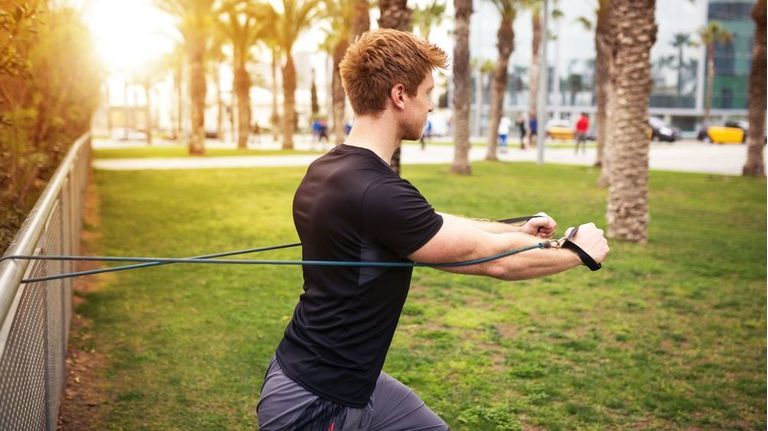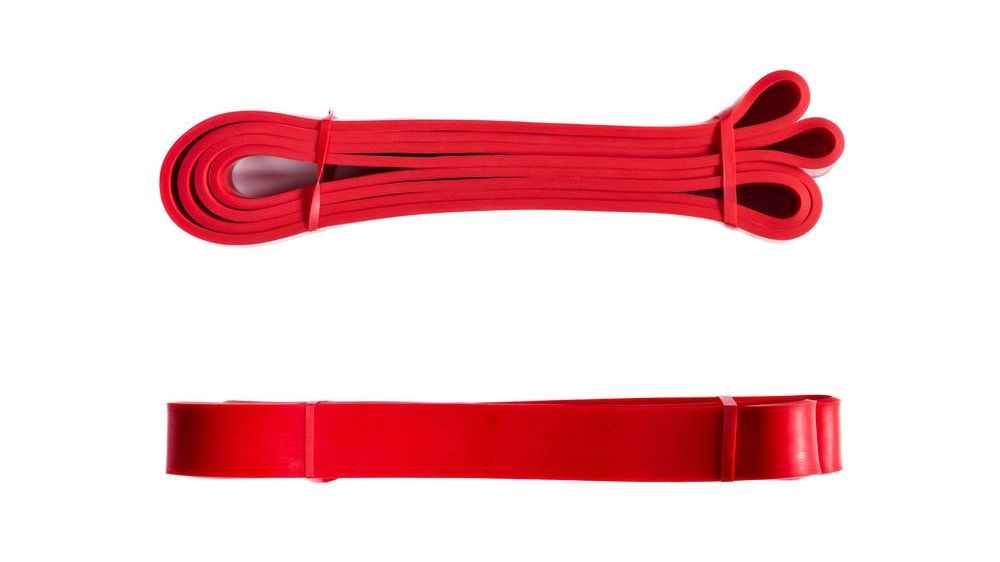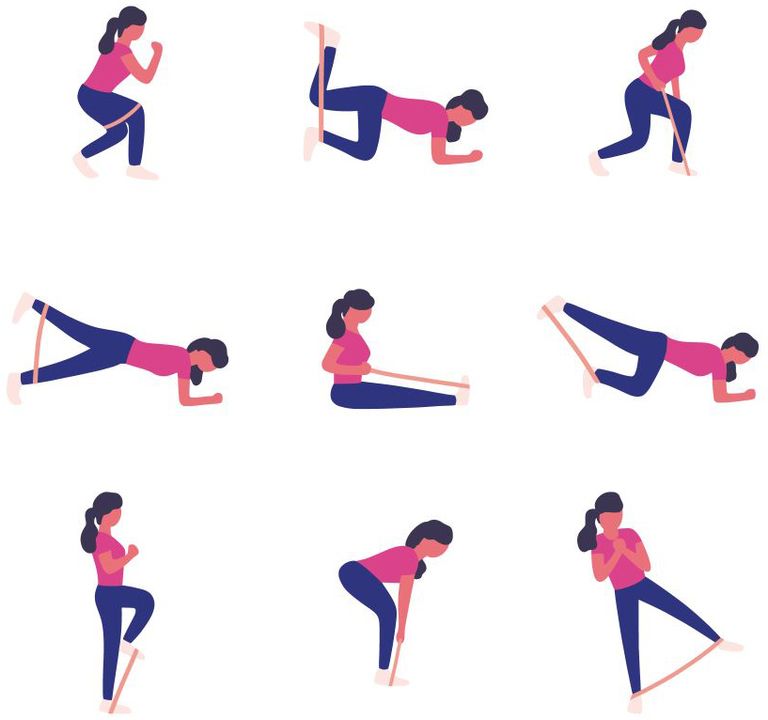Americans in the 21st century are health-and-fitness-conscious. They care about how they look and feel. So it should come as no surprise that millions of men and women of all ages exercises regularly.
But there are many ways to work out and get leaner, stronger and healthier. For some people, daily jogging best serves their needs. Others prefer using machines like treadmills to stay fit.

However, the majority of Americans that exercise regularly have always relied on “free weights” to build muscle, lose weight and increase stamina. But weights such as barbells and dumbbells can be costly and require lots of storage room, too.
The exercise method that has steadily grown in popularity over the past several years involves the daily use of resistance bands. There are many reasons why people who exercise prefer to work with these “elastic wonders.”
What Is Resistance Bands?
Resistance bands are generally flat, narrow bands constructed of rubber and elastic that stretch and are most helpful in strength training. They are also often used in physical therapy, primarily to convalesce muscle injuries or to aid in the rehabilitation of patients suffering from cardiac-related health problems because they are ideally-suited to a slow and careful rebuilding of muscle strength.

Interestingly, resistance bands have been in use since the early twentieth century, about one hundred years ago. At that time, they were constructed of surgical tubing and had a singular purpose, muscle rehabilitation.
Now, of course, resistance bands are crafted in flexible rubber, are available in a variety of forms and are used for general fitness and for strength training.
As might be expected with all types of exercise equipment, there are many advantages and some disadvantages associated with resistance bands.
Benefits Of Using Resistance Bands

There are many reasons why exercise buffs prefer using resistance bands instead of other types of equipment.
- Resistance bands are lightweight and portable: which means that they are very easy to use, a fact that makes your workouts much more enjoyable and rewarding. Their portability means you can take them with you anywhere you go. And that enables you to exercise away from home, even when you’re at work.
- Resistance bands are versatile: these short, rubbery bands generally have handles to make it easy to do your workouts. But, their versatility is due to the fact that you can use them so many ways. For instance, because they have handles on both ends, you can easily loop them around a pull-up bar, a tree limb or under your own feet to create instant “pulling” exercises like bicep curls, rowing, squats and many, many more.
- Resistance bands can be used in combination with other types of training equipment: for example, you can loop them over free weights to make your bench press exercise more difficult and more worthwhile.
- Resistance bands are safe to use: that means you can be more daring and perform movements you would not try with heavy weights because the risk of injury is slight and negligible.
- Resistance bands are practical and good for people of all ages: young and old alike can work out with Resistance Bands because they are easy to use. They are also good for building muscle and for rehabilitating injuries. That’s versatility.
- Resistance bands are very affordable: a single band can cost as little as $3.00. A full kit generally costs only about twenty dollars.
Clearly, resistance bands are the “tool” of choice for millions of people who exercise and work out regularly. They are lightweight, portable (just fold them up and take them with you) and versatile enough to use alone or with other equipment for a broad range of exercises designed to build muscle mass, increase strength, tone the body and increase fitness and health.
Best of all, you can use resistance bands to strengthen and develop a specific body part or for full body workouts. It’s your choice.
Of course, there are negatives for every product, as well and resistance bands are no exception. There are a few “cons” connected to the use of resistance band:
Resistance bands provide inconsistent levels of resistance: unlike free weights which give you the same amount of resistance at every point of a movement, Resistance Bands offer varying levels of resistance during an exercise. Stated another way, bands are easier to pull as you get closer to your body (or anchor point) and more difficult to pull as you get farther away. That leads to an inconsistent workout and that’s a big negative.
Resistance bands makes some workouts extremely difficult to do: consider the bench press as a good example. In order to provide enough resistance, you have to make the bands so tight that you end up dramatically limiting or reducing your range of motion. And that’s another negative.
Resistance bands are ineffective for bodybuilding and building true muscle mass: that’s because bands are much better suited for stretching exercises that increase flexibility and enhance stamina.
That’s it. There are virtually no other disadvantages associated with the use of Resistance Bands. As you now know, there is more to like than dislike for this type of workout equipment.
Type Of Resistance Bands
People who are familiar with resistance bands tend to think there is only one type of band that exists for a single type of workout. In fact, there are several types of bands available in online websites and at sporting goods stores all over the United States.

Here are the different kinds of resistance bands:
Therapy Resistance Bands are available without handles and are designed for use by recovering patients who require rehabilitation. They are generally used for simple stretching exercises and very light workouts.
Compact Resistance Bands have plastic handles at either end and are perfect for stretching and pulling exercises used in upper and lower body strength training and conditioning.
Fit Loop Resistance Bands are continuous flat loop bands used by exercise buffs for lower body workouts. They help to improve strength and fitness.
Figure 8 Resistance Bands are short bands in the shape of the number 8. They include two soft handles and are specifically designed for people interested in upper body workouts and strength training.
Ring Resistance Bands are flexible, circular bands that have two soft handles which make them practical for a broad range of exercises. However, they are generally used for lower body conditioning and strengthening.
Lateral Resistance Bands include Velcro ankle cuffs that are connected by bands and are ideal for lower body workouts. This form of band can often be found in rehabilitation centers where it is used to build leg strength and flexibility in patients recovering from illness or injury.
As you can see, resistance bands come in a variety of sizes, shapes and styles and are designed for specific purposes. The appropriate band can be used to build strength and muscle mass in a specific body part or can be used for a total body workout and overall fitness and health.
Importantly, these bands are suitable for use by young people, the elderly, men, women and children, too. In other words, everybody can use and benefit from resistance bands.
How To Choose The Right Resistance Band?
As is true for any product you can buy, there are good resistance band and bad ones. To make sure you choose wisely, start by deciding what type of band you want. Remember, as noted above, there are different types of bands designed for different, but specific, uses.
Importantly, resistance band come in different colors. Most, but not all, manufacturers use light colors to indicate that a band provides light resistance and a darker color to signify heavy resistance. When shopping, check the color of a band, but also read the product description on the package to make sure the band you’re looking at meets your specific need.
Once you decide on use, make sure you choose a “good” band. That is a band that is constructed in the kind of quality material that won’t “snap” or “whip” back at you and possibly hit you in the face if the handle accidentally slips from your hand while you’re working out.
Good, high quality rubber is what you want. You can determine if a band is well made by pulling at it in the store. You should also closely examine a band to make sure there are no signs of “wear and tear.”
Read reviews online before you make a purchase decision. You should be able to find out – in advance – if the band you want to buy is going to be worth the purchase price. It really is that simple.
Now, here’s something else to think about. Does it make sense to buy a resistance band or are free weights the better option? Read on.
Resistance Bands vs. Free Weights

You already know a few things about resistance band. What you still need to learn is this: how do bands stack up against free weights? What you find out will help you to make the right purchase decision.
So, let’s look at the “pros and cons” of both products. Let's start with resistance bands.
Resistance Bands
Pros
- Portability: bands can fold up to a very small size, fit in your pocket and go anywhere you go – easily. Free weights are not travel-ready.
- Versatility: bands can be used in just about every exercise that can be done with free weights. In fact, there are stretching exercises you can do with bands that can’t be done with heavy weights.
- Affordability: individual bands can be purchased for as little as $3 while bulk rolls of bands may cost about twenty dollars. Free weights are much more expensive.
- Special accessories: most bands come with “extras” like handles and door attachments that make them even more versatile and useful. The same can’t be said for free weights.
Cons
- Limited upside: bands provide only a finite limit of resistance. As such, at some point in your use of them you will find it difficult, perhaps even impossible, to continue to show improvement in your strength and muscle mass development.
That is the key negative connected to the use of resistance band. However, it’s a major shortcoming and something you will have to consider when making a purchase decision.
Now, let’s take a closer look at free weights.
Free Weights
To begin, free weights are any weights that are not attached to a machine, such as dumbbells, barbells and medicine balls.
Pros
- Multiple weight choices: there are many different weight levels you can choose, a fact that adds intensity and value to your workout. That is not possible with bands.
- Increasing the weight leads to greater muscle mass and strength: free weights like barbells and dumbbells come with a variety of weights which means you can add weight to your lifts and build your strength over time. You can’t do that with bands.
Cons
- Storage is difficult: hat’s because barbells, dumbbells and weighted medicine balls are big and bulky and take up lots of room in your home. Resistance Bands, on the other hand, fit easily into a drawer and require very little space.
- Free weights are budget-busters: they are generally priced per pound and cost much, much more than bands. In fact, as you increase weight, the cost can become prohibitive.
- Portability concerns: free weights are big and heavy and, as a result, they are not portable. Bands go where you go – easily.
That’s it. The information provided here should make it easier for you to make a purchase decision when you shop for exercise equipment.
Top 5 Resistance Band Workouts
Front Squats Are Great For Building Your Lower Body.
This exercise will help you to build lean muscle mass while enabling you to improve your fitness and health. Here is how it works.

- Start by standing on the Resistance Band with your feet spread slightly wider than your shoulder width.
- Bring your hands up to the top of your shoulders while holding a handle in each hand.
- Then, squat down and push back up.
- Repeat all steps until you reach your desired number of reps.
Lateral Band Walks Build Your “Glutes” And Your Core.
Here’s how it works:

- Strap the Resistance Band around both of your ankles.
- Step side-by-side (laterally) while in a semi-squat position.
- Stretch legs apart and bring them back slowly.
- Repeat all steps until you reach your required reps.
Note: this exercise enables you to work all of the major and minor muscles in your lower back and strengthen your hips. It is easy to do and perfect for men and women.
Build Your Back With Bent-over “Rows.”
This exercise replaces the need for an expensive rowing machine and produces the same results while saving lots of space in your home. Here is how it works.

- Stand on the Resistance Band with your feet about shoulder width apart.
- Keep your knees slightly bent.
- Pull the handles up toward your midsection in a rowing motion.
- Drop your hands and repeat the motion until you reach your desired number of reps.
This is an exercise ideally-suited for men and women.
A Top-notch Push-up … Bands Make Great Push-ups Possible.
Here is how they work:

- Loop the bands through each of your thumbs after draping the Resistance Band over your upper back and across your shoulders.
- Drop into push-up position.
- Start the exercise.
- Continue doing push-ups until you reach your desired number of reps.
It is a great way to build strength and endurance. It will also be challenging and rewarding for most men.
Military Presses Into Dumbbell Curls Builds Tremendous Arm Strength.
And they’re easy to do. Here’s how:

- Stand over a Resistance Band with your feet spread shoulder-width apart.
- Grab the handles and pull them up to your waist.
- Then, lift the bands up past your shoulders and over your head until your arms are fully extended.
- Bring the bands back down to your waist (slowly and while under control).
- Then, raise the bands again for a bicep curl.
- Repeat the process over and over again until you have completed your workout.
There are many more exercises you can do with Resistance Bands, but many experts agree that the five exercises described here are among the best you can do for building a specific part of your body, for full body workouts, for building strength and fitness and for improving the state of your health.
Importantly, the exercises are easy to do and suitable for men and women of all ages.
Consider your specific workout needs before you make your decision to purchase the best resistance band for you.
Summary
You are now armed with information to help you make the right selection when you visit a sports equipment store to buy a good resistance band. As noted earlier, there are many options available. Hope this guide can help you find the best one for you.
Get started today. And enjoy your workouts.

